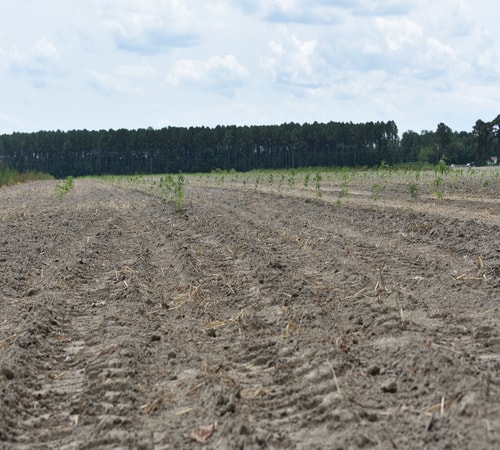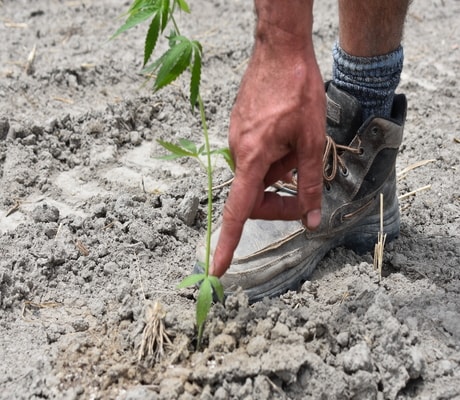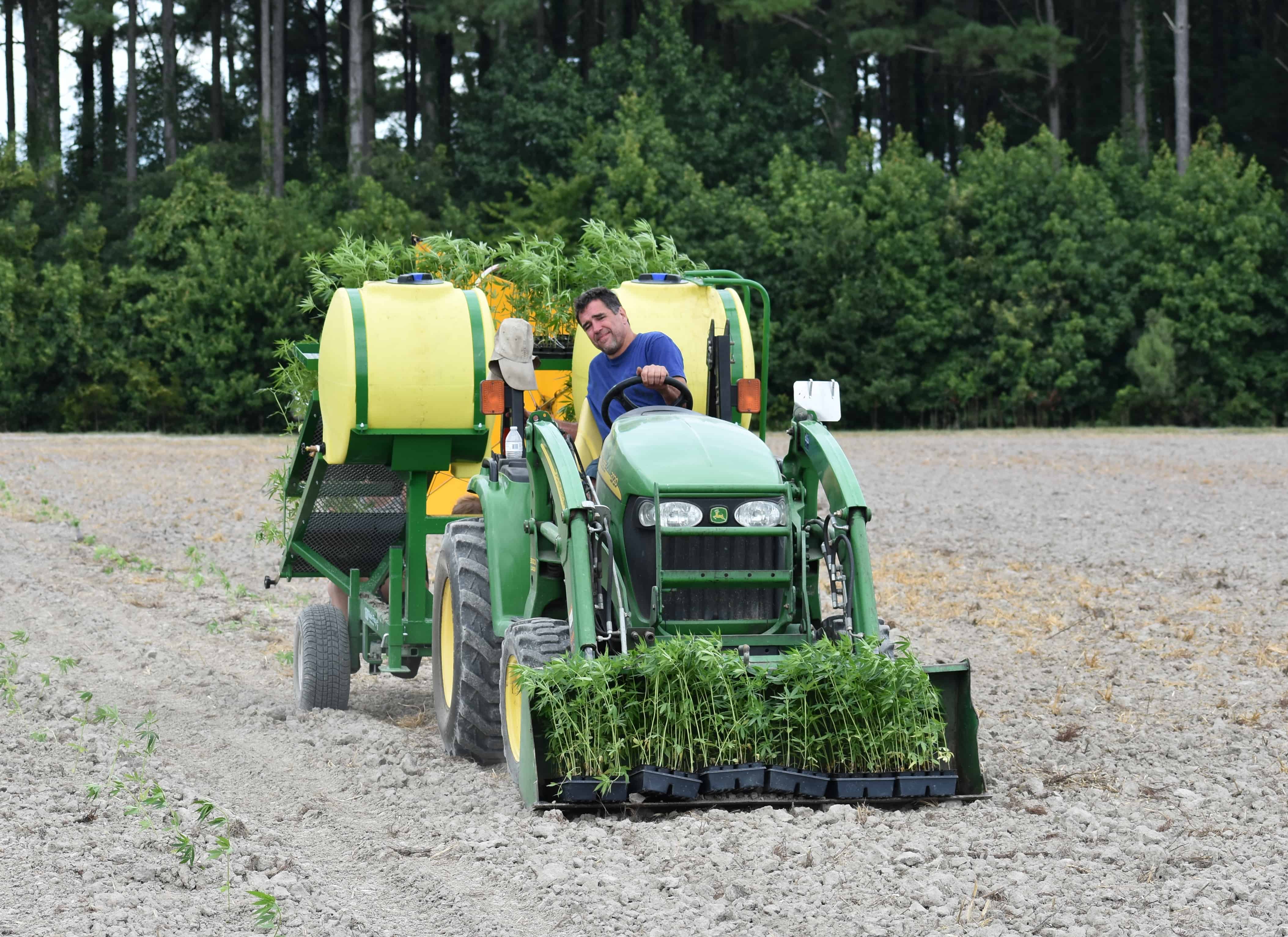GROWING HIGH CBD STRAINS
Growing CBD rich hemp can be a very rewarding change from the usual field crops. Not only is industrial hemp more profitable, it also rejuvenates the soil by naturally removing toxins and breaking up the soil with its large tap roots. High CBD hemp can be planted a multitude of ways. You can choose to start your crop with seeds, feminized seeds, female clones, or seedlings, both regular and feminized.
First and foremost, it is imperative that when growing industrial hemp, whether for high CBD extraction or for seed and fiber, that your state has a hemp program, usually run through universities, and that licenses are available to grow or you work with licensed growers to avoid any conflicts.
Climate
Hemp grows great from sunny California, to the high-altitude front range of Colorado, to the dry climates in Texas, the cold plains of Canada, and all over the country. Hemp is extremely adaptable to different weather conditions, although it can still be vulnerable to temperature extremes. Extreme heat can slow the growth of the plant and temperatures below freezing can kill the plants. Depending on the climate in your area, it is important that the strain of hemp, whether a fiber plant or a CBD rich hemp strain is chosen to provide optimal growth for the conditions. Many farmers chose to grow high CBD hemp strains in a greenhouse or hoop house environment which allows for a much longer growing season in colder climates. Starting seeds or clones year-round in greenhouses sets the farmer up to start the spring crop ahead of game with larger healthier, and more importantly FEMALE plants.

Cannabis is a dioecious plant. This means that its flowers are either male or female and usually not both (more on the alternative monecious characteristics in upcoming blogs). CBD is primarily stored in trichomes which are abundant in unpollinated female cannabis flowers. Alternatively, males produce no flower and females that have been fertilized by pollen will produce 50% or less of the normal cannabinoid value achieved in a female flower-only plant. This is because the fertilized female plant will put all of its energy into seed production, consuming the plants energy needed for flower production and CBD production. If you plant seeds instead of planting female clones, then approximately half of your crop will likely produce males; the average male to female ratio in seed. Since male plants do not produce flower, those male plants will contain insufficient cannabinoid value to extract. The additional pollination of the female plants from male pollen would further reduce the cannabinoid yield and likely ruin your chances for a successful, high CBD harvest.
With any CBD rich hemp plant harvest comes the risk of THC production in your crop. The legal limit is 0.3% THC for hemp. Any higher and the regulatory authorities over most any United States Agricultural / Industrial Hemp program will consider it marijuana. Your Hemp regulatory authority will require samples of your crop for testing. If the test result is over 0.3% THC by weight, then that sample has failed (also referred to as “hot”) and the farmer is legally required to destroy the crop.
Ideal Soil Type and Location
After considering climate, the next thing to look at is soil type. Hemp will grow in rocky soil in the western mountains to the rich soils of the Piedmont and Blacklands of eastern North Carolina. Optimal soil conditions for CBD rich hemp plants are well drained, nutrient rich soils with a pH on the acidic side between 6 and 6.8. Check the soil you are going to plant in and have it analyzed if needed to see what may need to be done to amend the soil for optimal conditions. The addition of a few simple products can make all the difference for a successful crop.

Here is a list of important factors to consider when growing high CBD industrial hemp:
Sunlight: More sunlight equals bigger plants and larger yields.
Wind: Airflow from a gentle breeze will strengthen the plants, help it develop healthy rhizosphere (root system), sturdy stems, and keep any molds and mildews from developing. Heavy winds however can damage your crop.
Security: Growing industrial hemp in areas with ease of general access by the public can be problematic due to people thinking this crop may be something that it's not, and people helping themselves to it. Smaller isolated fields, secure fields, and fields that aren’t right up against main thoroughfares are ideal.
Nutrients
Industrial hemp grows just about anywhere in just about any condition. When growing industrial hemp for high CBD production, it is important that the plant be given the nutrition it needs to maximize yields and high percentages of CBD. During early vegetative growth CBD rich hemp likes a nitrogen rich fertilizer. During the flowering stage, it performs best with a higher percentage of potassium and phosphorous. On a large grow of hundreds if not thousands of acres, industrial fertilizers are used for fiber and seed production. When growing on 4 acres to 40 acre plots, more care can be taken to give the plants the nutrients they need. Some soil amendments that can go into the soil prior to planting or transplanting are:
1. Compost
2. Kelp meal
3. Blood meal
4. Fish meal
5. Worm castings
6. Guano
These can all be mixed into the soil to provide the plant what it needs throughout the season. Another option is to make a compost tea utilizing some of these ingredients. This can be watered into the soil by hand or by drip irrigation as a fertilizer, or as a foliar spray that acts as a natural barrier to molds and mildews, as well as a deterrent to pests. Bacterial teas are best for foliar application whereas fungal teas are best for soil drench. Foliar application of compost teas can be done with watering hoses, industrial sprayers, or even aerial application.
Water Requirements

Obviously, your plants need water, and the benefit of growing outdoors is that your CBD rich hemp plants should be exposed to rainwater. However, in places like California, the hot summer months mean minimal rainfall, so you have to water your plants manually or through irrigation. The main danger is overwatering your cannabis. A good starting point is to assume that a large plant needs 10 gallons of water a day during hot weather.
Those who live in wetter than average climates need to improve drainage. Hemp that grows in waterlogged conditions is susceptible to root diseases.
Here are three ways to boost drainage:
1. Plant your hemp in beds or raised mounds.
2. Dig ditches to ensure that the water flows away from your plants.
3. Add clay pebbles, perlite, and gravel to the soil.
If you use tap water, test it first as it could have a significant number of dissolved minerals which build up in the soil and impact the pH level. Alternatively, tap water could contain an excessive amount of chlorine which is very bad for the soil. As a result, we recommend filtering the water you use where possible, especially when stating plants in a greenhouse.
Protecting Your Hemp Plant from Pets & Pests
Don’t make the mistake of focusing solely on bothersome insects; larger animals such as rodents, dogs, cats, rabbits, deer, and raccoons can trample or attempt to eat your crop. While insects damage your plants over a few days or weeks, larger animals can destroy them in a matter of minutes. It should go without saying that you must examine your industrial hemp plants regularly.
You should be able to deal with substantial animal threats by surrounding your plants with a high and sturdy wire fence. It is also possible to use household items such as garlic and castor oil or even urine from predators such as bears or coyotes to ward off rabbits, gophers, and raccoons.
Keeping your hemp fields safe from pests is a full-time job, unfortunately. First of all, it is imperative that you keep your plants healthy because blooming plants have a natural resistance to specific pests. You can add ladybugs and lacewings, as these predators keep harmful pests at bay while doing no damage themselves.
Pyrethrum is one of the most popular organic insecticide options, and there are homemade remedies such as combining soap with water and misting your plants with it. Garlic is a useful tool for fighting beetles. Check your plants daily for signs of infestation and act immediately if you see any issues. The aforementioned soap and water solution is effective against mild outbreak. There is also a myriad of organic products such as neem oil, stylet oil, and combination products such as geranium and garlic oils. Some of these products are great for pests such as mites and aphids as well as certain molds and mildews like powdery or downy mildew. Your climate will generally dictate the types of molds and mildews in your area. Dry regions have more powdery mildew issues whereas damp, humid regions will have issues such as botrytis (bud rot). Keeping on top of these using preventative measures above is the best way to avoid these problems.
Another method of fighting pests is through the addition of companion plants. These are plants of a different species to industrial hemp that you plant near your crop. Companion plants are specially chosen for their ability to repel pests. They include Clover, Rosemary, Basil, and Marigold.
One thing that these things cannot protect you from is blow over of pesticides, herbicides, and fungicides. The reason we recommend smaller secluded fields is the problem that has arisen from Glyphosate ready crops such as soy, corn, cotton, and others. Any overspray or blow over of this toxic chemical can completely destroy your hemp crop. Hemp is not resistant to this chemical and all caution should be taken. Developing a dialogue with neighboring farmers is imperative if they are using this pesticide.
Protecting Your Crop from Rain & Wind
High winds are a major problem for hemp growers as they break branches, damage trichomes and leave your plants vulnerable to disease and infestation. Any type of excess strain like this can over-stress the plants, causing the plants to become hermaphrodites, and the buds can self-pollinate to produce seeds. You do not want this to happen.
Planting in smaller plots of several acres surrounded by trees is the perfect remedy for high wind areas. Also planting in hoop houses in areas where secluded plots aren’t a possibility.
Although rainwater helps your plants grow, too much of it results in mold and mildew. The problem is at its worst during the flowering stage. If you live in a wet climate, chose a mold-resistant industrial hemp strain and support it with stakes or cages. Otherwise, rain will collect on buds and leaves, and your plants will be weighed down. Look for certified high CBD feminized seeds in your state for the strains best suited for your region.
Cannabis Seeds vs. Clones – Choosing What’s Best for Your Farm
The best genes equal the best plants and the highest ratio of CBD per lb. When you select high CBD hemp seeds or CBD rich hemp clones with good genetics, you are rewarded with a bud that smells and tastes gorgeous and is also extremely high in CBD and terpenes. Indoor growers tend to grow their hemp from clones, while outdoor growers prefer to grow from seed. You can get quality flower using either method, and they both have their advantages and drawbacks.

If you elect to clone, you need a mother plant which requires at least 16 hours of light a day to ensure it doesn’t flower. It is also possible to buy clones from hemp farmers in your area that are purveyors of seeds and/or clones. All clones are female plants that have the same traits and they are known for producing premium quality CBD rich hemp flower. You must root the clones indoors before they are ‘hardened off’ (the process of moving a plant outdoors for a few hours a day to gradually introduce them to air, cold nights, and sunlight.)
One important downside to using clones is that they produce small yields. If you want a more abundant harvest, you have to grow the clones indoors during the winter and early spring. Also, cloned hemp plants never develop the thick central root that goes into the ground, stabilizes the plant, and consumes groundwater (also known as the tap root). As a result, they are vulnerable to drought and windy conditions.
Plants grown from seed offer larger yields and are tougher in the face of inclement weather conditions. You can plant these seeds in the garden in the spring, even if it is still cold and wet outside. The tap root produced by plants grown from seed give them an important survival advantage. Not only is it a strong anchor for the plant, but it is able to reach water and nutrients deep below the surface. This is especially important during very hot and dry conditions. Another option is to begin the growing process indoors, but the high CBD hemp seedlings must be hardened off eventually before they are transplanted.
The chief downside to growing from seed is that the outcome is less predictable than it is with clones. If you don’t choose an inbred seed line, you could end up with a different plant to what you might have been expecting. Also, cannabis seeds produce males and females, which means you have to sex your plants when they achieve sexual maturity, a process that involves culling the male plants. You can avoid this issue by purchasing feminized seeds from a reputable source.
One other option for outdoor growing is auto-flowering seeds. As soon as they reach maturity, these plants begin to bloom irrespective of the length of the days. If you live in a temperate climate, you will benefit from two crops every year by using auto-flowering seeds. Simply plant one crop in late winter (or even early spring), and another at the beginning of summer. Auto flowering plants cannot be cloned.
Harvest
Depending on the strain and climate conditions, most high CBD hemp strains are ready for harvest between the end of September up to the end of October. Monitor pistil and trichome formation to gain a better idea of when your plants are ready for harvesting. Always have your strains tested throughout the crop for CBD and THC content to ensure you don’t go over the allowable 0.3% THC level for hemp.
You must be careful not to wait too long to harvest, because hemp plants suffer a decline in health once they have completed the flowering phase. If the pistils are turning red, harvest immediately! Other signs that it is time to harvest include brown resin on the buds, a broader stem, and if the leaves of the plant begin to turn yellow and die back.
Should you have any questions about starting your own high CBD hemp crop, do not hesitate to reach out to us. It is our goal to assist farmers and answer questions for our customers. Our continued success relies on the success of the farmer.




